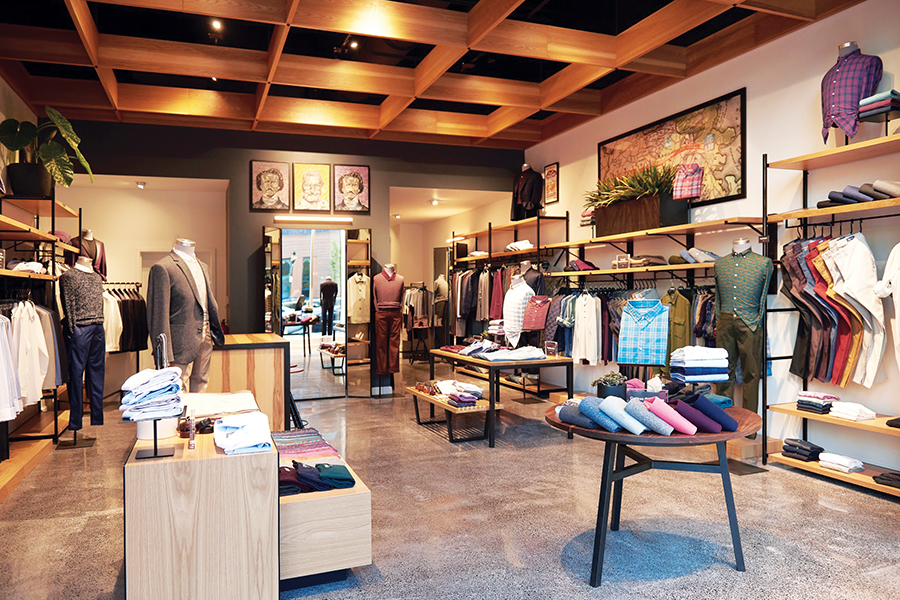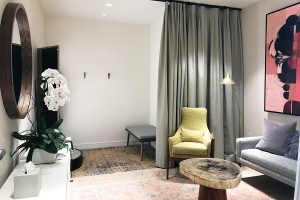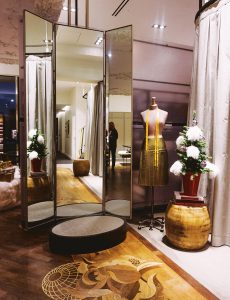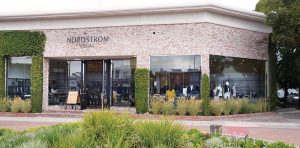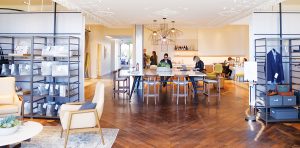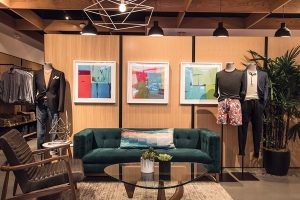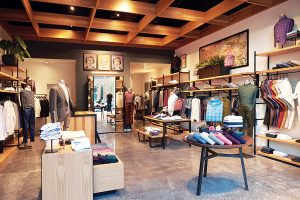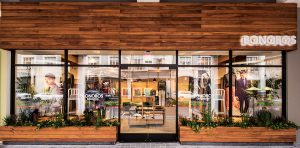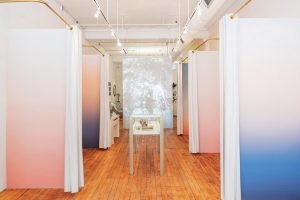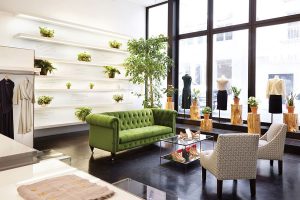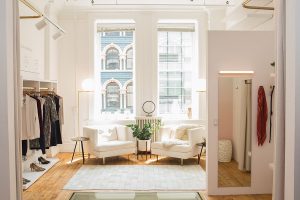What will our centres look like in the future (and that’s only a few weeks away!)? What will a shop look like, and how will it relate to the online business? We think about these issues and discuss them, but rarely reach a consensus because the topic is complex. Susanne Pini gives us a logical overview.
Retail is changing. Instead of overstocked places where you go to buy things, stores are increasingly becoming places where you go to experience things as people actually don’t have to go to stores anymore – they have to want to go. Hence, experimentation is the key and, to stay relevant in this day and age, some forward-thinking retailers are aspiring to become the desirable place to shop by using an intriguing strategy: create a cosier space that sells very little of anything – a showroom.
Showroom 101
Showrooms, an old retail model popular with car dealers and furniture designers, is rapidly being transformed and adopted by online apparel start-ups and even mass-market leaders like Nordstrom and Walmart. In these atelier-like places, shoppers can sip champagne while trying a cherry-picked selection of merchandise, and then place orders to be home delivered or collected later. The décor is usually chic and inviting, and the customer service is consistently lavish. This is the antithesis of the standard shopping mall experience, with the overwhelming assortment of products, queues, crowds and ever-too-busy sales assistants.
In essence, a showroom gives customers all of the tactile advantages regular stores always did but, because there’s little or no on-site stock, they have many operational and competitive advantages over traditional bricks-and-mortar.
They require less space, inventory is centralised and merchandise theft is minimal. Retail locations like these, stripped of retail’s usual fixings like checkout counters, intricate floor displays and vast stockrooms, also free employees from the chores of restocking, folding and cleaning displays. As a result, staff can devote more attention to actual customers, giving showrooms a competitive edge. According to research from consulting firm PWC, that face time results in higher sales, a decreased likelihood of returns and even increased e-commerce business, since existing customers have already been shown the offerings and know what size they take.
Nordstrom Goes Local
Last year, American upscale retailer Nordstrom opened the first prototype of a new store concept called Nordstrom Local, in West Hollywood, California. The store is 914m2, compared to 42,000m2 for their average department store, and it has no merchandise for sale. Designed more like an exclusive boutique crossed with a hipster bar, than your usual bricks-and-mortar outpost, it’s meant to be an exciting and personalised experience. Here you can meet with a personal stylist, who brings in a small selection of clothes picked out just for you. It’s also a place to get manicures, have a glass of wine as well as pick up or return an online order.
- The first prototype of a new store concept – Nordstrom Local, in West Hollywood
- The first prototype of a new store concept – Nordstrom Local, in West Hollywood
- The first prototype of a new store concept – Nordstrom Local, in West Hollywood
- The first prototype of a new store concept – Nordstrom Local, in West Hollywood
Located on a very visible corner, it seems perfect for a retailer looking for foot traffic, but that’s not really what Nordstrom is after here as you can’t just make an impulse buy at a store that offers nothing to buy. The new inventory-free retail concept is simply a smaller, more personal, service-oriented experience, designed to be a neighborhood hub for busy West Hollywood residents where people do not come to shop – at least not in the traditional sense.
The store does include some clothes for shoppers to try on, but there is no inventory to purchase on site. Inside, the shop is airy – less clothing means more room for dressing rooms in a variety of formats, but all with living room-style furniture and enough space for a group of friends. At the back wall there is a well-stocked bar and, next to it, a nail table with eight different manicure services, making it alone enough reason to drop by!
In the middle is a large desk equipped with iPads, where personal stylists meet with clients. Appointments can be pre-booked and the consultations are free of charge. Stylists guide shoppers to a personalised wardrobe, assist in selecting a gift or outfit for special occasion, all of which customers can then order online to be delivered later or to the store that same day.
The idea is to keep shoppers from feeling overwhelmed by too much choice. If shoppers want to wait for the clothing to arrive, they can have another drink or relax and have a manicure.
The stylists can also pick a selection of items and new looks for customers through a Pinterest-like app called Style Boards. They create digital boards filled with personalised fashion recommendations, which can be viewed by the customer on their mobile device and then ordered through Nordstrom website. Desired items can be also made to measure at the Trunk Club, in-house alteration and tailoring service where a team of experts will help clients select the right fabrics to create a custom garment.
The new concept is an experiment emphasising pampered service, speed and convenience, claims Shea Jensen, Nordstorm’s senior vice president, and retail experts agree they may be onto something by offering a different, more intimate approach at Nordstrom Local. Fortune magazine goes further by declaring that Nordstrom is the first retailer that actually understands what we want. Instead of a point of sale, the Local aspires to become a physical manifestation of the Nordstrom brand, creating indulgent customer experiences that can be completed with purchases through any of the retailer’s other channels. The store also has a convenient curbside pickup where customers who have bought items online can pick up their purchases, get them altered for free if needed or return them altogether. This helps ease some of the nuisance of online shopping, similar to what Amazon and other online retailers are trying to do with their network of physical stores.
Clicks to Bricks
Showrooming, also referred to as interconnected retailing or ‘bricks and clicks’, as coined by the Harvard Business Review, is rapidly being adopted by innovative online retailers as the physical store gives them a chance to connect with their fan base and deliver high-touch customer service, theoretically making customers more loyal to the brand.
Bonobos, an iconic New York menswear retailer that launched exclusively online in 2007, is one of the first e-companies to extend into bricks and mortar. Originally the startup was created to exploit the opportunity to sell to men conveniently online because they thought stores were going away at that time, Bonobos founder Andy Dunn admits. However, he changed his mind after the company, working on developing a new line, had customers come in to try on samples. They wanted to try on other products, too, and started “buying like crazy”.
The research actually shows that online-only players that open a store see an increase in sales of five to eight times.
Bonobos opened up its first so-called Guideshop in 2012 in New York and now has more than 40 locations all over the US. The Guideshops have a small footprint, around 400m2 and typically feature a cosy seating area reminiscent of a living room in a Manhattan loft, where shoppers can sit and drink free beer from the local brewery. The place feels roomy as most customers book free fitting appointments online, so there’s usually only two or three customers and as many employees at most in the small store at a time.
- The Bonobos Guideshop
- The Bonobos Guideshop
- The Bonobos Guideshop
At first glance though, the Guideshop might look like any other traditional retail environment, but the store is actually inventory free, featuring a full display of merchandise, one in each colour and size, all for try-on purposes only. There are no registers at Bonobos and no distinctive shopping bags, as customers don’t walk out of the stores with their purchases. Instead, you get one-on-one experience with a guide (or ‘Ninjas’, as they are known) who will first offer you a beer and then go through a personalised tour and the fitting procedure and help you place your order online. Finally, customers’ measurements are recorded and stored, so any future items they decide to buy are easily picked out online, and will still be tailor made to fit perfectly.
The whole idea of what’s convenient is changing, argues Dunn, who doesn’t like to fight crowds, drive to stores, queue up at dressing rooms and checkouts and carry heavy shopping bags. “There’s a lot of hyperbole about retail dying, but it’s just that the model’s changing,” Bonobos’ CEO suggests, and the rise of showroom brands proves that there is still a place for a physical experience, but you just have to think differently about how you do it.
Like Bonobos, MM.LaFleur is a posh New York clothing company, started as an exclusively online business, but things didn’t go well until they began opening pop-up shops around the city and they realised that shoppers – professional women, in their case – really liked the stress-free, one-on-one attention by highly trained staff that only a physical store can offer.
Today, MM.LaFleur has grown to five locations nationally and is a showroom brand. “Think of it as a salon for professional women, with a library full of books and plenty of coffee and Prosecco on hand,” says founder Sarah LaFleur.
- MM.LaFleur features stylish seating areas and generously sized dressing rooms
- MM.LaFleur features stylish seating areas and generously sized dressing rooms
- MM.LaFleur features stylish seating areas and generously sized dressing rooms
Instead of a visible clothing store, typically there is a white, clean reception area with bare plank floors that could well belong to a trendy design firm. Upon arrival, an MM.LaFleur stylist greets you with a glass of champagne and custom-curated pieces waiting in the fitting room. After the fitting, the purchases are delivered to your home free of charge.
The stores feature a large stylish seating area and generously sized dressing rooms, yet they are still less than 300m2. And it’s not just a matter of size, but also of location with most stores reached only by elevator. Since many of MM.LaFleur’s customers make an appointment to come in, the store doesn’t need traditional street appeal, plus career-wear sold at MM.LaFleur is not really something they feel is an impulse purchase.
The Future is Now
Analysts agree the showroom concept is not just the merchandising strategy of the future, but it could be the store of the future. Although the model itself is quite old, it seems like the logical next evolutionary step for retailing, in part because many consumers are already using stores as showrooms, starting with the Apple phenomenon, whose hands-on-centric stores changed the focus from buying to trying. Checking stuff out in stores, then ordering online, is becoming the new way to shop and according to the recent survey from IBM, nearly half of all online shoppers are using this technique.
As an indication of where things are going, Walmart, the world’s largest retailer, surprised the industry by acquiring Bonobos and a couple of other showroom brands last year.
After all, according to the recent survey by WD Partners, showrooms are viewed as the single most influential retail innovation driving purchase today, ranking above others such as ‘click and collect’, retail mobile apps, food service on site, experiential retail, artificial intelligence and pop-up stores.
Recently, many chains have started exploring the model and some, like Macy’s, have already tried and failed. Obviously, not all stores can make the idea work and not all customers are ready to change the way they shop – yet. Asking shoppers to give up that joy of an immediate gratification is like asking them to turn their backs on what makes shopping fun. But, while there will always be a segment of consumers who want the rush and the excitement, clients of showroom apparel stores tend to be more affluent, urban millennials in search of professional or custom-made clothing – clothing, it follows, that they don’t mind waiting for. In these appealing buy-free, hassle-free stores consumption happens, but it’s secondary and the shoppers’ increasing willingness to sacrifice the instant gratification is clearly a sign of the times. As New York Times’ recent article summed it up, the rationale is simple: “Instant gratification takes a back seat to visceral experience”.


